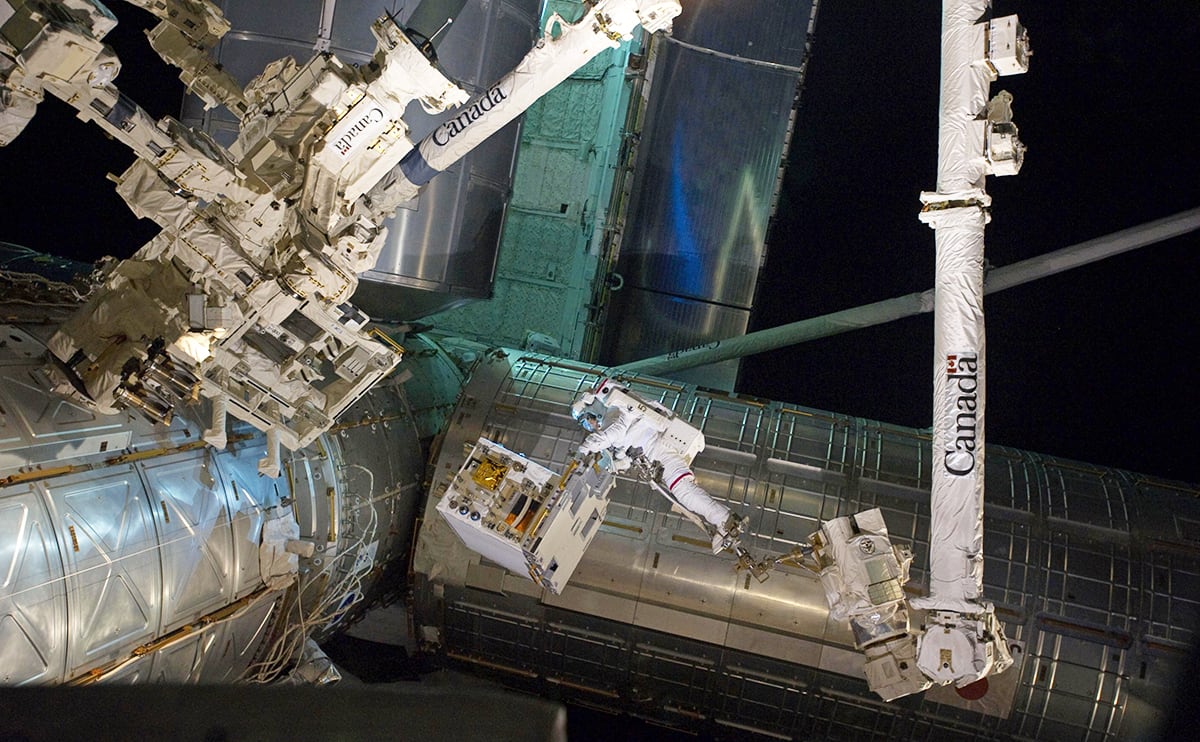Published on: 11/8/2015IST
Here's what the astronauts aboard the ISS have been up to

The first piece of the International Space Station (ISS) was launched into orbit in 1998 and two years later, its first occupants arrived. It's currently the largest artificial body orbiting the planet and much of it's devoted to testing aspects of living in space. When astronauts aren't busy exercising, eating or working on David Bowie covers, they're knee-deep in an endless array of experiments and observations. We've gathered a sampling of those projects to see just what they've been working on over the years in their orbital laboratory.

Deep Space DIY
3D-printing tests have been underway in the Destiny lab aboard the International Space Station since September 2014 to verify its practical uses in zero-g. So far, experiments with low-temperature plastics have been successful and the ISS is approaching its goal of having an on-demand machine shop in orbit.
Eye in the sky
Farmers and ranchers have been receiving valuable images in both infrared and visible light, helping to inform their decisions on land use. The International Space Station Agricultural Camera (ISSAC) has been focusing its lens on the North American Great plains to provide these views, often with as little as one to two days turnaround time.
ISSAC also gathers planet-wide info about the changing environment, including deforestation and glacial melting.

Photo ops
The Crew Earth Observations (CEO) experiment has been ongoing aboard the ISS since the year 2000, although astronauts have been taking snaps from orbit since the Mercury missions in 1961. Its goal is observation, providing insight into Earth's wonders from a unique perspective and keeping a watchful eye during times of disaster.

The NightPod
It's tough to capture long-exposure photographs when you're circling the Earth at Mach 17. That's where the European Space Agency NightPod project comes into play. It's a tracking-device technology that compensates for movement, improving photos of our planet, especially those taken during low-light situations.

Slow returns
The ISS has been deploying a series of small Technology Education Satellites (TechEdSat / TES) as testbeds for new technology. The latest launches of TES-4 have been aimed at developing its Exo-Brake, which is a non-propulsive means of de-orbiting spacecraft for a controlled return to the surface.

Over exposure
The Materials International Space Station Experiment (MISSE) has been deliberately exposing various materials to the harsh environment of space. The samples are reviewed to show their reaction to direct sunlight, radiation, and extremes of heat and cold. These tests help inform hardware, optics, sensors, coatings, structural materials and more for upcoming missions.

The Pro K diet
The negative effects of long-term space travel and zero-g on human bones has been under investigation for a while, but astronauts may have a way to combat it: The Pro K project. It's a diet with a decreased ration of animal protein to potassium. The mix aims to fight the decrease in bone mineral loss and could inform the food production systems on future missions.

Fill 'er up
As it stands, there are plenty of satellites orbiting the planet that weren't designed to be serviced and refueled. The Robotic Refueling Mission aims to make the ISS into a service station that can handle those tasks, with the help of a two-armed robotic handyman named Dextre. Here astronauts unload the mission module and place it on a temporary platform near the robot.

Robotic assistant
Robonaut has been onboard the ISS since 2011, but it wasn't until 2014 that he got his legs. The intelligent robot has been working on its dexterity and ability to respond to unexpected obstacles. In the future, it be tasked with projects both inside and outside of the station. Robonaut can operate autonomously, but can also be controlled through a virtual reality teleoperations system. The user can control its movements when they're fitted with specialized gloves, a vest and a visor with a three-dimensional view.

Motion control
The Synchronized Position Hold, Engage, Reorient Experimental Satellite (or SPHERES) is one of the few Department of Defense experiments onboard the ISS. Originally launched in 2006, and continuing today, this experiment tests new technology in zero g for autonomous and controlled flight. Each SPHERE is self-contained and has a CO2-based propulsion system, which allows them to achieve coordinated movements and even dock with each other.

Long-distance remote control
To prepare for future explorations, astronauts have been training to remotely control surface rovers from their location in orbit. The Surface Telerobotics experiment was set in place to validate previous tests and drum up more useful info about the difficulties involved in remote operation from a space environment.

Feeling the effects
Being up in space can really go to your head. The Test of Reaction and Adaptation Capabilities (TRAC) tracked astronauts before, during and after stays on the ISS to test a theory about brain adaptation in a microgravity environment. While in space, hand-eye coordination tests showed reduced accuracy in comparison to being on Earth. Luckily, the effect was reversed once astronauts returned to Earth's surface.
Outerspace agriculture
NASA astronauts have been doing a bit of gardening on the ISS. The Veg-01 project was a hardware validation experiment to demonstrate the ability to grow and harvest veggies in orbit. The direct followup called Veg-03 has moved on to testing modified water delivery systems and expanding the crop beyond the initial "outredeous" red romaine lettuce plants from Veg-01

Fuel economy
If you think gas is expensive on Earth, the propellant used to rotate the ISS for maneuvers like docking with resupply vehicles costs nearly $10,000 per pound. The Zero-Propellant Maneuver (ZPM) demonstrated controlled movement without any fuel use at all. Instead, the ZPM helped spin the space station using gyroscopes, which leveraged stored momentum (powered by solar energy) and focused it towards specific attitude trajectories. Mission control compares their predicted momentum usage against actual flight telemetry data in the image shown here.
11/8/2015 | | Permalink


